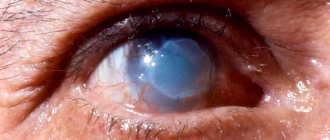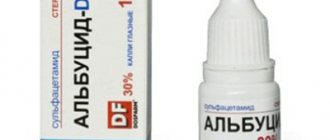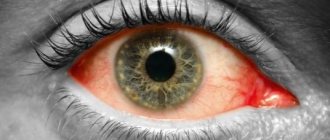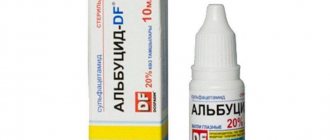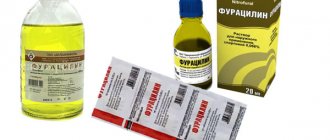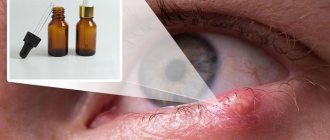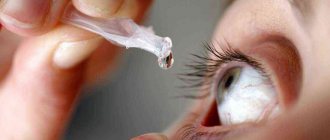Causes of conjunctivitis in pregnant women
Eye inflammation is associated with various factors. The main ones include:
- Presence of a foreign body in the eyes.
- Improper wearing of contact lenses, against this background, contact conjunctivitis can develop.
- Impact of allergens on the mucous membrane (plant pollen, house dust, cosmetics). In this case, allergic conjunctivitis occurs.
- Failure to comply with hygiene rules.
- Colds, flu, viral infections.
- In diseases of the ENT organs, a bacterial form of the disease may occur.
- Vitamin deficiency, malnutrition.
In each case, the reasons may be individual.
Indications for taking drops during pregnancy
It is obvious that the use of eye drops is advisable for a wide variety of disorders and ailments.
The main indications for the use of eye drops for pregnant women:
- Dry eye syndrome. The development of this disorder is associated with hormonal changes that occur in the female body after fertilization of the egg and during the further development of the fetus. The main symptom is a feeling of dryness, which is accompanied by the sensation of a foreign body under the eyelids. With this syndrome, it is not recommended to use contact lenses. Moisturizing eye drops are used for treatment.
- Edema. The occurrence of swelling in the eye area is associated with a delay in the removal of fluid from the body. This causes an increase in the amount of blood. As a rule, swelling disappears on its own after childbirth, but during pregnancy it can seriously bother the expectant mother.
- Redness of the eyes. Red eyes are a fairly common phenomenon, which, like swelling, is provoked by an increase in the volume of blood circulating in the female body during pregnancy. In this condition, the small capillaries that are located in the eyeball burst due to increased pressure.
- Ingress of household chemicals and foreign bodies. With such disorders, patients experience severe tearing, as well as a burning sensation, and possible short-term visual impairment. In this case, the use of antiseptic eye drops is the most optimal method of treatment.
- Eye stye. This disease is associated with inflammatory processes that occur in the area of the hair follicles that are located under the eyelashes. With this disease, the edge of the eyelid swells greatly, which is associated with inflammation, as well as the accumulation of pus. Treatment with drops allows you to produce a disinfecting effect and speed up the process of tumor resorption.
- Cataract. With pathology, clouding occurs
the eye lens, as a result of which vision is severely impaired and the ability to recognize colors is reduced. This in turn leads to various difficulties in carrying out daily activities. Treatment of the disease is carried out through surgery. Various drops are used during the rehabilitation period to restore the functions of the visual analyzer.
There is a wide range of indications that may be associated with ophthalmic diseases.
Symptoms
This pathology is accompanied by pronounced symptoms. Among them are:
- increased lacrimation;
- irritation and redness of the mucous membrane;
- swelling;
- feeling of dryness or sand in the eyes;
- sensitivity to light;
- painful sensations that intensify when blinking;
- purulent discharge, especially observed in the morning.
Sometimes patients with this disease experience weakness, headache, and increased body temperature. At the first suspicious signs, you should consult a doctor and not self-medicate. This is very important during pregnancy. Not all medications are suitable for expectant mothers, especially in the first trimester. Lack of treatment can cause serious consequences.
Photo
In the images you can see what eyes look like with this pathology:
In what cases may a pregnant woman need ophthalmic medications?
Eye drops during pregnancy are prescribed only if there is a real problem; using them “just in case” or for prevention is strictly not recommended. Although these drugs are used topically, some of the active components enter the general bloodstream, penetrate the placenta into the fetus and can affect its development.
On the other hand, any infection during pregnancy is extremely dangerous and also has a very negative effect on the baby’s health. Even minor, sluggish inflammatory processes need to be treated. And this is where correctly selected eye drops for pregnant women will help, effective and at the same time safe for the expectant mother and child.
Indications for the use of drugs are:
For each of these cases, there are drugs that can quickly and safely solve the problem.
When you need to see a doctor urgently
- Can't relax or tense your hand
- It is not possible to hold or lift even heavy objects in your hand
- After an injury or blow, severe pain occurs and joint deformation is noticeable
- The pain bothers you at night and during rest, does not go away for several days
It happens that when pain develops, it is impossible to alleviate the condition at home. The following situations require immediate medical attention:
- any hand injury;
- redness of the skin in the joint area and on the palm from the outside;
- numbness of the limb. Burning pain, aching the whole arm;
- inability to move a hand, paralysis of a limb;
- when the pain in the arm is combined with a burning sensation in the chest area, the body aches.
The situations listed above require calling emergency services. A burning pain in your left arm may be a sign of a heart attack. That's why you shouldn't delay getting medical help.
Forms of conjunctivitis during pregnancy
There are a large number of types of conjunctivitis that can affect the human body. All of them are accompanied by inflammation of the mucous membrane. Only a doctor can determine the form of pathology after a full diagnosis. Basically, conjunctivitis is divided into:
- allergic;
- viral;
- bacterial;
- contact.
Once the etiology of each type has been determined, treatment can be selected accordingly.
Allergic
If a woman had allergic reactions before pregnancy, then in an interesting situation they tend to worsen.
The reason lies in the body’s incorrect reaction to various stimuli. These may include: plant pollen, animal hair, some medications, chemicals and household products. This form of pathology is accompanied by the following symptoms:
- unbearable itching;
- increased and uncontrolled lacrimation;
- sensitivity to light;
- redness;
- simultaneous damage to both eyes.
There is no discharge from the eyes. When severe, they may have a slimy consistency. If you eliminate contact with the irritant, the symptoms will go away on their own without taking medications.
Viral
Such inflammation can occur against the background of ARVI. This is due to the general damage to the body by pathogenic viruses. This type of conjunctivitis has characteristic symptoms:
- Initially, the inflammation affects one eye, and after a few days the second;
- severe lacrimation appears;
- severe swelling;
- mucous discharge from the eyes.
If the cause is associated with an adenoviral infection, then cough, rhinitis, and fear of light occur. If not treated in a timely manner, the pathology can spread to the cornea. Against this background, a decrease in visual acuity is observed. Dry eye syndrome may often occur after treatment. The herpetic form of conjunctivitis can occur due to pregnancy. This is due to a strong decrease in immunity, which contributes to the activation of the herpes virus. In this case, the following signs appear:
- the appearance of bubbles with liquid inside on the eyelids;
- if such a bubble bursts, pain, burning and severe itching appear;
- the appearance of severe headache;
- increase in body temperature.
Bacterial
This disease develops against the background of damage to opportunistic microorganisms. Among them are: streptococci, gonococci, pneumococci, staphylococci. Often the reason may be hidden in the presence of ARVI. In addition to a runny nose and cough, unpleasant symptoms appear in the eyes.
Failure to observe personal hygiene rules and touching your eyes with unwashed hands can lead to the development of this form of the disease. Typical symptoms include:
- profuse purulent discharge of yellow or green color;
- Initially, one eye is infected, and after a few days both;
- itching;
- sensitivity to light;
- swelling and redness of the conjunctiva.
What eye drops can be used during pregnancy?
Many women often wonder what eye drops are available during pregnancy in case of inflammation and eye disease.
There are the following reasons why eye problems occur:
Bacteria. With this disease, pregnant women may have a greenish fluid discharge from the eye, and the eyelids may also swell and the whites may turn white. A bacterial infection can affect one eye or two at once.
If eye problems are caused by a virus, then within 1-2 days you may experience severe redness of the eyes, as well as severe itching and increased lacrimation. Conjunctivitis in a viral form can affect both eyes at once.
Raises his hand
If you pull your arm and it hurts in the shoulder area, radiating to the elbow, then the cause is usually a sprained ligament or muscle strain.
Overexertion most often occurs in people who sit at the computer for a long time. Nagging pain occurs due to the accumulation of salts in the muscle mass of the shoulder joint and in the tendons. If you try to raise your arm or move your limb back, the pain becomes stronger.
Treatment
How to treat the pathology if you are worried about pain from the shoulder to the elbow, the doctor decides after a diagnostic examination and finding out the cause of the discomfort.
MORE ABOUT: Fracture of the olecranon process consequences photo
The examination may include the following procedures:
- X-ray examination of joints. The image shows how much the structure of bones and cartilage tissue has changed after the lesion.
- Ultrasound diagnostics is performed to identify salt deposits in the joint.
- MRI allows an accurate diagnosis.
- Arthroscopy. This procedure will determine where the pain is localized. If necessary, surgical intervention can be performed directly during the examination.
- Biopsy. A cell analysis is taken if a joint tumor is detected.
- Urine and blood tests.
Based on the results of a comprehensive examination, a diagnosis is established and treatment is prescribed. Treatment for pain in the elbow and shoulder can be traditional and folk.
Traditional methods
Traditional treatment is aimed at eliminating the cause of the pain and further eliminating the symptoms of the pathology.
Pain can usually be managed with conservative methods. It happens that it is impossible to do without surgical intervention, which is necessary in the following situations:
- bone and muscle tissue becomes ill;
- visible joint deformation;
- hernia between the vertebrae;
- tumor. There are suspicions that the neoplasm is cancer.
If there is no need for surgical intervention, then you can treat with traditional methods, consisting of the following measures:
- A course of medications.
- Physiotherapeutic sessions.
- Physiotherapy.
As drug therapy for pain in the shoulder and elbow, drugs for external and internal use from the following groups are prescribed:
- non-steroids: Diclofenac, Nise;
- hormones. These drugs are prescribed if it is not possible to relieve inflammation with the help of non-steroids;
- painkillers: Pentalgin, Baralgin, Nurofen;
- chondroprotectors: Teraflex, Chondroitin;
- injections with hyaluronic acid.
If a malignant tumor is detected in the joint, then special antitumor drug therapy is prescribed.
After eliminating the symptoms with the help of medications, a course of physical therapy is performed. Depending on the diagnosis, electrophoresis, magnetic therapy, and current treatment may be prescribed. Physiotherapeutic sessions can be attended only after acute pain has been relieved.
Traditional treatment
Using folk methods when your arm hurts badly, starting from the shoulder and moving to the elbow, it is important to understand that folk procedures cannot cure the pathology. Any folk remedy can be used only after consultation with your doctor. You can get rid of the problem only in combination with prescribed traditional treatment.
Before using traditional treatment methods, you need to make sure that you are not allergic to the products used in the recipes. The following folk remedies will help improve your well-being:
- Baths with mustard effectively relieve spasms and swelling. The bath is filled with not very hot water, then 5-6 tablespoons of mustard or mustard powder are added. You can lie in such water for no longer than 10 minutes.
- Baths help a lot when my hands hurt. Add 10 drops of parsley and orange essential oils to a small container with a liter of water. Baths can be done up to 3 times a day for a week.
- Compress. For preparation you will need leaves and flowers of viburnum and lilac. Pour boiling water (100 g) into a teaspoon of herbal mixture. When the infusion has cooled a little, wet the gauze and make a compress overnight or for several hours.
- Vodka compress. Add 1 tsp to a glass of vodka. honey The gauze compress must be firmly secured.
Baths and compresses help temporarily relieve burning and swelling, and reduce inflammation in the sore arm.
During treatment, it is necessary to avoid hypothermia, drafts, and high physical activity.
You need to understand that pain in the hand is also characteristic of a serious pathology. Failure to seek medical help in a timely manner may result in disability.
Diagnostics
There are many external and internal factors that provoke the development of conjunctivitis. It is often diagnosed against the background of other ophthalmological diseases. The doctor conducts a visual examination, listens to the patient’s complaints, and studies the medical history. To determine the cause and type of disease, he prescribes bacteriological tests and laboratory tests. It is important to determine the causative agent of the pathology in order to prescribe effective treatment. Improper therapy can lead to the development of chronic conjunctivitis.
Treatment
The treatment method can be determined by the doctor after confirming the diagnosis. During pregnancy, many drugs are prohibited. Therefore, complex therapy using folk remedies is often prescribed. Self-medication is strictly prohibited.
Medicines
After determining the cause of the disease, the doctor prescribes appropriate therapy. It mainly consists of taking antibacterial, antihistamine, painkillers, and anti-inflammatory drugs. It is also necessary to take immunostimulants. The duration and course of pregnancy should be taken into account. List of medications:
- To wash the eyes and eliminate secretions, use the following solutions: Furacilin, boric acid, a weak solution of potassium permanganate.
- Ointments for placing in the conjunctival sac are rarely prescribed.
- Eye drops are used taking into account the pathogen. Mainly prescribed: Tobrex, Ciloxan, Albucid. These drugs are not considered safe and are prescribed in extreme cases. Floxal is strongly not recommended for pregnant women.
Folk remedies
Traditional medicine can be used in the absence of an allergic reaction to plants. Therefore, before using them, you should consult your doctor. Such products are suitable only for topical use as compresses and infusions for rinsing:
- Chamomile. This is the safest plant. Dried flowers are used to prepare a decoction or infusion. A not very concentrated infusion is prepared. It is suitable for washing eyes. Has an antibacterial, antiseptic, anti-inflammatory effect. Not recommended for allergic conjunctivitis.
- Aloe. It is important to consider that a plant that is more than 3 years old has medicinal properties. You need to take a few leaves and squeeze the juice out of them. It is diluted with a small amount of water, and the finished solution is used for washing. Dry leaves can be used. They are poured with boiling water.
- Althea. For the infusion you will need the dried root of this plant. It should stand for 24 hours. After this, you can wash your eyes with it. The flowers also have medicinal properties and can be added to an infusion.
Before using such products, you should consult your doctor.
Rules for using eye drops during pregnancy
To use eye drops during pregnancy and get the desired results from them, you need to follow several recommendations.
- Only a doctor should prescribe medicine after examination. An important point is the correct selection of eye drops that are allowed at the time of pregnancy.
- In the first twelve weeks, you should not use drops that contain carbonic anhydrase and blockers, since if they penetrate into the blood, they can have an adverse effect on the development of the baby.
- In the second trimester, blockers and other types of eye drops can be used, but under the strict supervision of a doctor.
- In the last ten weeks, it is better not to use any eye products at all, as there is a possibility of suppression of the nervous system of the unborn baby.
- The drug must be instilled correctly. Doctors advise closing your eyes for a few minutes after use. If the inflammatory process is observed in both eyes, then the product should be instilled alternately after ten minutes so as not to exceed the concentration of substances entering the blood.
- All eye drops have an expiration date. Once opened, they should be stored in the refrigerator for no more than thirty days. After this, throw away the bottle, even if there are remains of the medicine.
- All pregnant women should visit an ophthalmologist more often and have their intraocular pressure measured.
- If dry eye syndrome occurs during pregnancy, it is allowed to use moisturizing drops in the form of Visine, Oksial, Oftolic and Vidisica.
Any drug has a number of contraindications and side effects when used. Therefore, if an inflammatory process in the eyes occurs during pregnancy, then you should urgently consult a doctor. After all, eye drops during pregnancy can be replaced with traditional methods of treatment. This includes lotions with herbal infusion, brewing black or green tea, or simply using saline solution.
How to treat?
How and with what to treat conjunctivitis during pregnancy?
A peculiarity of the treatment of conjunctivitis during pregnancy is the need for careful selection of drugs .
If the disease is allergic in nature , standard antihistamines , while topical medications for pregnant women are more preferable than taking medications orally .
External eye rinsing with a solution of furatsilin or a weak solution of potassium permanganate is also recommended.
During pregnancy, it is recommended to use only the following drops and medications :
- Levomycetinis and Sulfacyl (used only in extreme cases, with heavy discharge from the eyes);
- Azelastine;
- Levocabastine;
- Allergodil;
- Ketotifen;
- Maxidex and Prenacid (corticosteroid drugs that have a number of contraindications during pregnancy, especially in the early stages , so they must be used with caution and in strict accordance with the instructions for use);
- Diclofenac.
For washing the eyes, the drug “Artificial tear” is suitable , which, in the absence of active chemical components, is absolutely safe for pregnant women.
For bacterial conjunctivitis, you can use such common drops as Tobrex and Floxal.
These drops will not have any effect on the fetus, and in addition to treating conjunctivitis in pregnant women, these drugs are also used to treat this disease in newborns .
Attention! Doctors prefer to avoid prescribing oral medications and recommend such medications only if there is no effect from the treatment of the above drops.
"Albucid" during pregnancy: eye drops against bacterial inflammation
Albucid - antibacterial eye drops
This drug is very popular due to such characteristics as speed and price.
For adults, 30% Albucid is prescribed. During pregnancy, a 20% solution of drops is instilled into the eyes.
The drug belongs to the group of antibacterial drugs and is used topically.
With severe inflammation, a certain amount of drug components may penetrate into the bloodstream.
Instructions for use and dosage of the drug
It is not recommended to use the medication on your own. After all, using the product produces a side effect: immediately after instillation, a strong burning sensation is felt. If it is difficult for a woman to endure such an action, then the drops can be diluted with saline solution.
Typically, the regimen for using the drug is as follows: 1 drop no more than 6 times a day into the affected eye. After the first improvements, the time between instillations is increased. It is better not to use the drug for longer than 5 days, otherwise complications are possible.
No matter how safe the drug may seem, it still has side effects and contraindications. Therefore, a visit to an ophthalmologist is very important. After all, only a specialist will tell you which eye drops can be used during pregnancy and which are better replaced with traditional methods. So take care of yourself and your unborn baby.
Complications
If treatment was incorrect or untimely, the disease may become chronic. Therefore, treatment should be carried out by a doctor after determining the type and cause of conjunctivitis. All expectant mothers are most interested in the question of what consequences there may be for the baby. Contact and allergic conjunctivitis is not dangerous and goes away after the irritant is eliminated.
Chlamydia infection poses a potential risk to the child. Against the background of decreased immunity, the pathology manifests itself in this form if the woman is a carrier of the infection. This can cause the following negative consequences:
- intrauterine infection;
- premature release of water;
- premature birth;
- infection of the child during childbirth.
To avoid such consequences, it is necessary to undergo examination before conceiving the baby.
Prevention
It is very important to understand that if one eye festeres, then if hygiene rules are not followed, damage to the second can quickly occur. In order to avoid getting conjunctivitis, you should strictly observe sanitary rules and personal hygiene. Doctors do not recommend using decorative cosmetics during pregnancy. This can cause irritation and allergies. Also, do not rub your eyes or touch them with dirty hands.
During pregnancy, it is necessary to ensure that hand and face towels are individual. They must be washed often and must be ironed. Also, household utensils and other items must be personal. Only by following these recommendations can you reduce the risk of contracting this disease.
